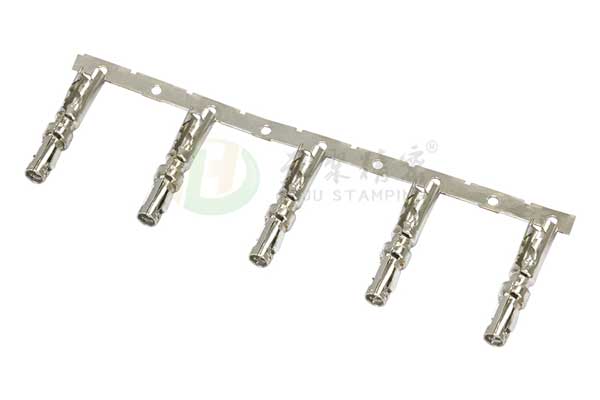Analysis the Most Crucial Metal Sheet in High-voltage Connectors-Stamped Terminals
Having worked in this industry for a long time, I’ve come to realize that high-voltage connectors look complex—plastic shells, shielding layers, various locking mechanisms—but what truly determines their success or failure, what ensures the obedient flow of current, is often the most inconspicuous metal piece inside—what we call a “stamped terminal.”
In this business, customers often ask, “How are your terminals different from others?” My answer is always, “They may look the same, but the real skill lies in what you can’t see.”
Materials: Not All Copper is the Same
A terminal, in essence, is a carefully crafted conductive path. Its foundation is copper, but there’s a lot more to it than meets the eye.
- Choosing materials is like a traditional Chinese medicine doctor prescribing medicine
We handle many copper alloy grades, C1801, C151… Which one to use depends on balancing conductivity, strength, and bending cycles. Pure copper is soft, has good conductivity but insufficient strength; adding other elements increases strength, but may slightly decrease conductivity. This “balance point” is what we repeatedly work on in the lab every day.
- Electroplating isn’t about thicker plating
Many customers directly ask, “Do you plate silver?” Yes, but the key isn’t just whether it’s silver, but the uniformity of the plating, the size of the crystal grains, and the underlying treatment. We’ve seen too many instances where the surface is shiny, but the flaws are exposed during electrical durability testing. The real skill lies in making the plating and substrate feel like they’re integrated, enduring thermal cycling and frequent insertion and removal without peeling or oxidation. This is the key to the long-term stability of high-current terminals.
Dies: A Micrometer Difference Can Completely Change the Look
Terminals are stamped, and the die is its “genes.” If the genes are bad, no amount of subsequent remedial work will help.
- Progressive dies aren’t just about having many stations
Some of our dies have dozens of stations. The design considers not only stamping out the shape but also the stress changes and fiber flow of the material during progressive stamping. A poorly handled radius or a burr on the shear surface can become the starting point for fatigue fracture later.
The precision and consistency of stamped terminals are 90% determined by the progressve stamping die. Our precision stamping for EV terminals relies on top-tier progressive die stamping automotive technology.
- Progressive Die Design
A single die integrates dozens of stations for punching, bending, stamping, and cutting, directly transforming a roll of copper strip into a finished terminal. This design is key to achieving high-speed stamping terminal production and micrometer-level tolerances.
- Microstructure Forming
The mold precisely shapes the spring arm structure, locking barbs and current bridging area of the terminal. These micro-features directly determine the insertion and extraction force, holding force and current distribution of the terminal.
Production: Stability is More Important than Speed
Our workshop’s punch presses can run very fast, but we value one word even more: stability.
The electric vehicle market requires hundreds of millions of high-reliability terminals. This necessitates that a stamping terminal manufacturer possess the capabilities of a high-volume stamping supplier.
- We trust data, not luck
We have real-time online monitoring; any abnormality in pressure, stroke, or speed will trigger an alarm. We monitor the CPK stamping process through statistical process control to ensure the long-term capability and stability of the stamping process, thereby guaranteeing impeccable consistency for every million terminals.
- Full inspection is not just taking a picture
The machine vision system is like performing a “CT scan” on each terminal, not only checking for dimensional accuracy but also inspecting the surface for mold scratches and plating defects. A micron-level flaw is a ticking time bomb in the face of a high-voltage arc. If we overlook a problematic terminal, it could result in a serious recall for the customer.
We don’t Just Sell Terminals, We Sell Peace of Mind
In the fierce competition of electric vehicles, the value of a custom terminal stamping partner goes far beyond merely manufacturing parts. Ultimately, when you choose a stamping terminal manufacturer like us, you’re not buying a bunch of metal parts; you’re buying peace of mind.
Will your battery pack lose power during bumps? Will your motor performance be affected by increased contact resistance? Can your fast charging interface withstand tens of thousands of plug-and-play cycles? The answers to these questions are already determined the moment that the roll of copper strip is stamped.
So, the next time you examine a high-voltage connector solution, don’t just look at how cool the casing is. Cut one open and examine the workmanship of the terminals inside, or simply come and talk to us.
We may not use many fancy words, but we can explain in detail the 100% effort we put in behind the scenes to make it even one ten-thousandth more reliable.
